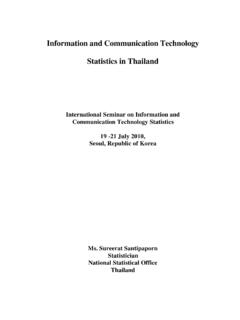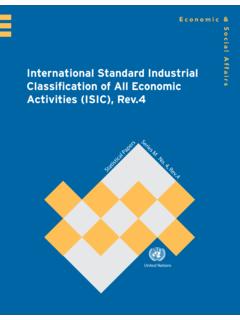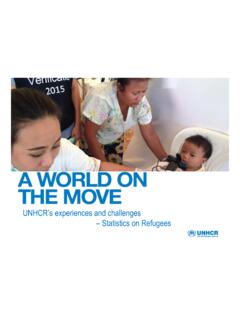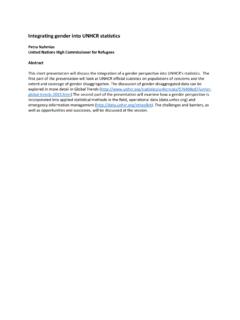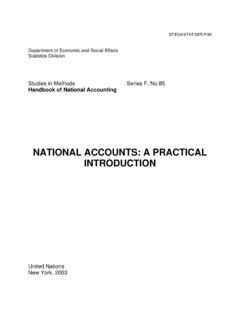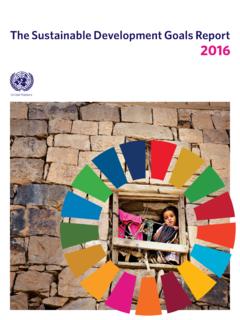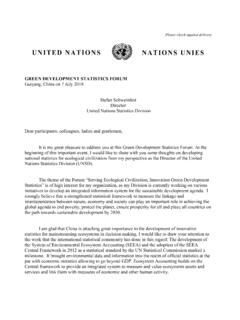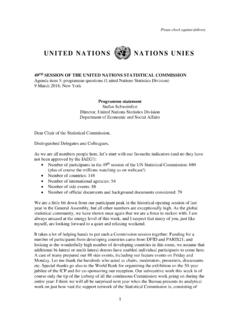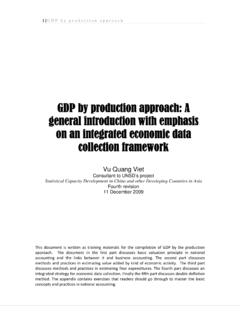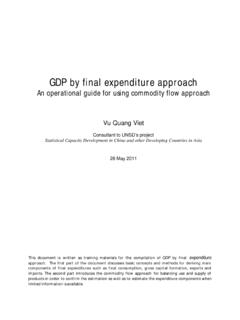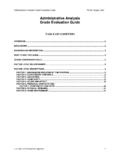Transcription of Central Product Classification (CPC), Version 2
1 ST/ESA/ Department of Economic and Social Affairs Statistics Division Statistical Papers Series M No. 77, Central Product Classification (CPC). Version White cover publication, pre-edited text subject to official editing United Nations, New York, 2015. Department of Economic and Social Affairs The Department of Economic and Social Affairs of the United Nations Secretariat is a vital interface between global policies in the economic, social and environmental spheres and national action. The Department works in three main interlinked areas: (i) it compiles, generates and analyses a wide range of economic, social and environmental data and information on which States Members of the United Nations draw to review common problems and to take stock of policy options; (ii) it facilitates the negotiations of Member States in many intergovernmental bodies on joint courses of action to address ongoing or emerging global challenges; and (iii) it advises interested Governments on the ways and means of translating policy frameworks developed in United Nations conferences and summits into programmes at the country level and, through technical assistance, helps build national capacities.
2 Note The designations used and the presentation of material in this publication do not imply the expression of any opinion whatsoever on the part of the Secretariat of the United Nations concerning the legal status of any country, territory, city or area, or of its authorities, or concerning the delimitation of its frontiers or boundaries. The term country as used in this publication also refers, as appropriate, to territories or areas. Symbols of United Nations documents are composed of capital letters combined with figures. Mention of such a symbol indicates a reference to a United Nations document. ST/ESA/ UNITED NATIONS PUBLICATION. Sales No. < to be assigned >. ISBN: < to be assigned >. Copyright United Nations, 2015. All rights reserved iii Preface The Central Product Classification (CPC) constitutes a complete Product Classification covering all goods and services1. It serves as an international standard for assembling and tabulating all kinds of data requiring Product detail, including statistics on industrial production, domestic and foreign commodity trade, international trade in services, balance of payments, consumption and price statistics and other data used within the national accounts.
3 It provides a framework for international comparison and promotes harmonization of various types of statistics related to goods and services. The first Version of the CPC, the Provisional Central Product Classification , was published in 1991. This Version was superseded by the Central Product Classification (CPC). Version , published in 1998. In that publication particular attention was paid to the elaboration of the services part of the Classification . CPC Version , published in 2002, represented a further update to the CPC, incorporating modifications due to recent changes in economies worldwide and sustained technological advancement in the period since the development of CPC. Version The CPC Version 2, released in 2008, again reflected recent changes in the character of outputs, in particular related to fast developing services industries. In addition, extensive detail had been introduced in the CPC to better describe agricultural and related products and information products.
4 A conceptual review of products covered in the CPC has also led to the introduction of a broader concept of goods and services. The current edition, CPC Version , is the result of a scheduled review of the CPC structure and detail to ensure the classifications'. relevance for describing current products in the economy. The changes in this Version are mostly results of further reviews of agricultural products (including fishery, forestry and agricultural inputs), outputs of selected service industries, energy products and necessary adjustments to reflect changes made in the Harmonized Commodity Description and Coding System. The ongoing revision of this Classification is evidence of the commitment to systematize the improvement of the Classification over time, keeping it current and making it more responsive to existing economic and technological reality while maintaining conceptual consistency. The primary purpose of CPC Version is to classify the goods and services that are the result of production in any economy.
5 This production is accounted for in the national accounts of countries and can be measured and analyzed using the System of National Accounts (SNA). CPC. Version is useful in studying transactions in goods and services in detail. It can also be used as a basis for developing lists of goods and services for specific purposes, such as price statistics surveys, tourism statistics surveys or ICT-related surveys, with its primary advantage being that it meets the criteria of an international standard. It has broad acceptance and facilitates the maintenance of systems of categories of products, both with regard to character and definition. It can therefore serve as a framework for international comparison. 1. See detailed discussion on goods and services in Part One, chapter of this publication. v Contents Page Preface .. iii Historical Background .. vii Acknowledgements .. xi Support for users of the CPC .. xii Acronyms and abbreviations.
6 Xiii Part One - Introduction I. Overview .. 3. II. The underlying principles of the Classification .. 7. A. Purpose and nature of the Classification .. 7. B. Principles used in constructing the CPC .. 8. C. Goods, services and other products .. 9. D. Coding system of the 12. III. Application of the Classification .. 13. A. Rules of interpretation .. 13. B. Explanatory notes .. 15. IV. Other topics .. 17. A. Using the CPC in establishing national classifications of products .. 17. B. Use of different levels of the Classification .. 18. C. Relationship of the CPC to other classifications .. 18. 1. Relationship to the International Standard Industrial Classification of all Economic Activities .. 18. 2. Relationship to the Harmonized 19. 3. Relationship to the Standard International Trade Classification .. 20. 4. Relationship to other classifications and standards .. 20. D. Correspondence tables .. 22. E. Alphabetical index to the Classification .
7 22. F. Alternative structures .. 22. Part Two - Broad structure Broad structure of CPC Version (Sections and divisions) .. 27. Part Three - Detailed structure Detailed structure and correspondences of CPC Version subclasses to ISIC Rev. 4, Harmonized System 2012 and CPC Version 2 .. 31. vi Part Four - Explanatory notes Section 0 Agriculture, forestry and fishery products .. 141. 1 Ores and minerals; electricity, gas and 191. 2 Food products, beverages and tobacco; textiles, apparel and leather products . 198. 3 Other transportable goods, except metal products, machinery and equipment . 263. 4 Metal products, machinery and equipment .. 318. 5 Constructions and construction services .. 382. 6 Distributive trade services; accommodation, food and beverage serving services; transport services; and electricity, gas and water distribution services .. 402. 7 Financial and related services; real estate services; and rental and leasing services.
8 440. 8 Business and production 462. 9 Community, social and personal services .. 537. Part Five - Alternative structures A. Overview .. 579. B. Products of the information economy .. 580. C. CPC expansion for agriculture statistics .. 586. Part Six - Changes in CPC Version 2 and Version A. Overview .. 599. B. Methodological changes .. 599. C. Structural changes .. 600. vii Historical background The Central Product Classification originated from initiatives in the early 1970s to harmonize international classifications prepared under the auspices of the United Nations and other international bodies, in economic statistics and other fields. In the follow-up to those initiatives, a standard Classification of all products was perceived as a key element. Based on the recommendations of an expert group convened by the United Nations Secretariat, the Statistical Commission at its nineteenth session in 19762 approved a programme to harmonize the existing activity classifications of the United Nations, the European Communities and the Council for Mutual Economic Assistance and to simultaneously develop a system of different, but interrelated, classifications of economic activities and goods and services.
9 The new Classification covering both goods and services - the Central Product Classification (CPC) - was intended to provide a basic tool in this programme. This proposed Product Classification would use the detailed subheadings of the Harmonized System as building blocks for the part dealing with transportable goods and would take into account the basic categories of economic supply and use as specified in the System of National Accounts, such as intermediate consumption, final consumption, capital formation, and imports and exports. The Statistical Commission endorsed the programme and supported its continuation at subsequent During the period 1977-1987, the Statistical Office of the United Nations Secretariat and the Statistical Office of the European Communities (EUROSTAT) convened six meetings of the Joint Working Group on World Level Classifications for the purpose of developing an Integrated System of Classification of Activities and Products (SINAP) to serve as an interim Classification .
10 The categories of SINAP were intended to be used as building blocks for the second revision of the International Standard Industrial Classification of All Economic Activities (ISIC),4 the General Industrial Classification of Economic Activities within the European Communities (NACE),5 and for related classifications of goods and services. The Joint Working Group also contributed proposals on the relationship between the SITC and the CPC. During the period 1983-1988, the Statistical Office of the United Nations Secretariat organized a series of expert group meetings on economic classifications including representatives from national, regional and international statistical offices to review the drafts of the ISIC, and the CPC, which had been prepared by the Statistical 2. Official Records of the Economic and Social Council, Sixty-second Session, Supplement No. 2 (E/5910), para. 128(c). 3. Official Records of the Economic and Social Council, 1981, Supplement No.
